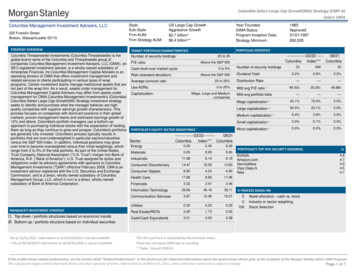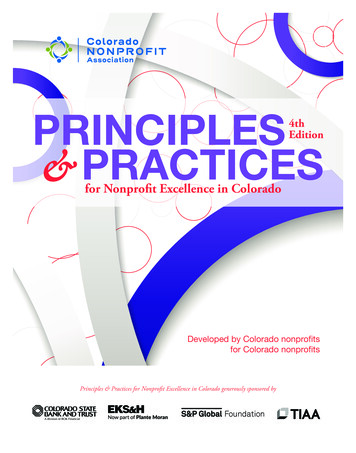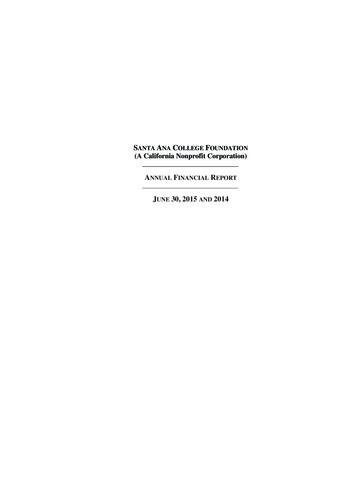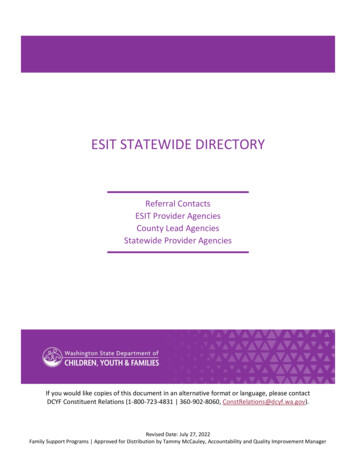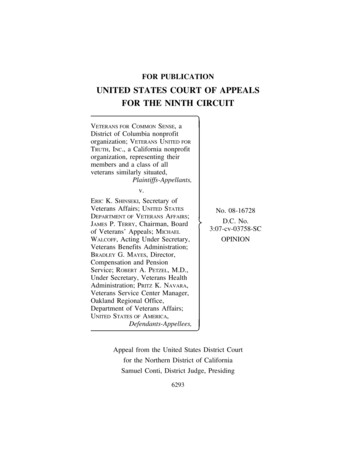
Transcription
FOR PUBLICATIONUNITED STATES COURT OF APPEALSFOR THE NINTH CIRCUITVETERANS FOR COMMON SENSE, aDistrict of Columbia nonprofitorganization; VETERANS UNITED FORTRUTH, INC., a California nonprofitorganization, representing theirmembers and a class of allveterans similarly situated,Plaintiffs-Appellants,v.ERIC K. SHINSEKI, Secretary ofVeterans Affairs; UNITED STATESDEPARTMENT OF VETERANS AFFAIRS;JAMES P. TERRY, Chairman, Boardof Veterans’ Appeals; MICHAELWALCOFF, Acting Under Secretary,Veterans Benefits Administration;BRADLEY G. MAYES, Director,Compensation and PensionService; ROBERT A. PETZEL, M.D.,Under Secretary, Veterans HealthAdministration; PRITZ K. NAVARA,Veterans Service Center Manager,Oakland Regional Office,Department of Veterans Affairs;UNITED STATES OF AMERICA,Defendants-Appellees, No. 08-16728D.C. No.3:07-cv-03758-SCOPINION Appeal from the United States District Courtfor the Northern District of CaliforniaSamuel Conti, District Judge, Presiding6293
6294VETERANS FOR COMMON SENSE v. SHINSEKIArgued August 12, 2009San Francisco, CaliforniaSubmitted September 14, 2009Filed May 10, 2011Before: Alex Kozinski, Chief Judge, Procter Hug, Jr. andStephen Reinhardt, Circuit Judges.Opinion by Judge Reinhardt;Dissent by Chief Judge Kozinski
6298VETERANS FOR COMMON SENSE v. SHINSEKICOUNSELGordon P. Erspamer (argued), Heather A. Moser, Ryan G.Hassanein, M. Natalie Naugle, and Stacey M. Sprenkel, Morrison & Foerster LLP, San Francisco, California; and SidneyM. Wolinsky, Ronald Elsberry, Katrina Kasey Corbit, andJennifer Bezoza, Disability Rights Advocates, Berkeley, California, for the plaintiffs-appelants.Michael F. Hertz, Acting Assistant Attorney General; JosephP. Russoniello, United States Attorney; and William Kanterand Charles W. Scarborough (argued), Appellate Staff, CivilDivision, Department of Justice, for the defendants-appellees.OPINIONREINHARDT, Circuit Judge:On an average day, eighteen veterans of our nation’s armedforces take their own lives. Of those, roughly one quarter areenrolled with the Department of Veterans Affairs (“VA”)health care system. Among all veterans enrolled in the VAsystem, an additional 1,000 attempt suicide each month.Although the VA is obligated to provide veterans mentalhealth services, many veterans with severe depression or posttraumatic stress disorder (“PTSD”) are forced to wait weeksfor mental health referrals and are given no opportunity torequest or demonstrate their need for expedited care. Forthose who commit suicide in the interim, care does not comesoon enough. Like the cavalry of Alfred, Lord Tennyson’s“Charge of the Light Brigade,” these veterans may neither“make reply” nor “reason why” to the “blunder” of thoseresponsible for their safety.Veterans who return home from war suffering from psychological maladies are entitled by law to disability benefits
VETERANS FOR COMMON SENSE v. SHINSEKI6299to sustain themselves and their families as they regain theirhealth. Yet it takes an average of more than four years for aveteran to fully adjudicate a claim for benefits. During thattime many claims are mooted by deaths. The delays haveworsened in recent years, as the influx of injured troopsreturning from deployment in Iraq and Afghanistan has placedan unprecedented strain on the VA, and has overwhelmed thesystem that it employs to provide medical care to veterans andto process their disability benefits claims. For veterans andtheir families, such delays cause unnecessary grief and privation. And for some veterans, most notably those sufferingfrom combat-derived mental illnesses such as PTSD, thesedelays may make the difference between life and death.In this context, two non-profit organizations, Veterans forCommon Sense and Veterans United for Truth (collectively“Veterans”1), seek injunctive and declaratory relief to remedythe delays in (1) the provision of mental health care and (2)the adjudication of service-connected death and disabilitycompensation claims by the VA. Among other issues, Veterans ask us to decide whether these delays violate veterans’due process rights to receive the care and benefits they areguaranteed by statute for harms and injuries sustained whileserving our country. We conclude that they do.We do not reach this answer lightly. We would have preferred Congress or the President to have remedied the VA’segregious problems without our intervention when evidenceof the Department’s harmful shortcomings and its failure toproperly address the needs of our veterans first came to lightyears ago. Had Congress taken the requisite action and rendered this case unnecessary even while it was pending beforeus, we would have been happy to terminate the proceedingsand enter an order of dismissal. Alternatively, had the VAagreed with Veterans following oral argument to consider a1We use the term Veterans to refer to the two plaintiff organizations aswell as to their members throughout.
6300VETERANS FOR COMMON SENSE v. SHINSEKIpractical resolution of the complex problems, the end resultsurely would have been more satisfactory for all involved. Wejoined in our dissenting colleague’s suggestion that we defersubmission of this case in order to permit the parties toexplore mediation, and we regret that effort proved of noavail. We willingly acknowledge that, in theory, the politicalbranches of our government are better positioned than are thecourts to design the procedures necessary to save veterans’lives and to fulfill our country’s obligation to care for thosewho have protected us. But that is only so if those governmental institutions are willing to do their job.We are presented here with the question of what happenswhen the political branches fail to act in a manner that is consistent with the Constitution. The Constitution affirms that thePeople have rights that are enforceable against the government. One such right is to be free from unjustified governmental deprivation of property — including the health careand benefits that our laws guarantee veterans upon completionof their service. Absent constitutionally sufficient proceduralprotections, the promise we make to veterans becomes worthless. When the government harms its veterans by the deprivations at issue here, they are entitled to turn to the courts forrelief. Indeed, our Constitution established an independentJudiciary precisely for situations like this, in which a vulnerable group, that is being denied its rights by an unresponsivegovernment, has nowhere else to turn. No more critical example exists than when the government fails to afford its injuredor wounded veterans their constitutional rights. Wars, including wars of choice, have many costs. Affording our veteranstheir constitutional rights is a primary one.There comes a time when the political branches have socompletely and chronically failed to respect the People’s constitutional rights that the courts must be willing to enforcethem. We have reached that unfortunate point with respect toveterans who are suffering from the hidden, or not hidden,wounds of war. The VA’s unchecked incompetence has gone
VETERANS FOR COMMON SENSE v. SHINSEKI6301on long enough; no more veterans should be compelled toagonize or perish while the government fails to perform itsobligations. Having chosen to honor and provide for our veterans by guaranteeing them the mental health care and othercritical benefits to which they are entitled, the governmentmay not deprive them of that support through unchallengeableand interminable delays. Because the VA continues to denyveterans what they have been promised without affordingthem the process due to them under the Constitution, our dutyis to compel the agency to provide the procedural safeguardsthat will ensure their rights. When the stakes are so high forso many, we must, with whatever reluctance, fulfill our obligation to take this extraordinary step.2We affirm the district court’s rulings with respect to Veterans’s various claims for specific forms of relief under theAdministrative Procedure Act, including their claims forsystem-wide implementation of various VA mental healthcare initiatives and their claims for the alteration of disabilitycompensation adjudication procedures in VA regional offices.We conclude, as did the district court, that the relevant provisions of the Administrative Procedure Act prevent us fromgranting Veterans the statutory relief that they seek. Wereverse, however, the district court’s rulings on Veterans’sconstitutional claims. We hold that the VA’s failure to provide adequate procedures for veterans facing prejudicialdelays in the delivery of mental health care violates the DueProcess Clause of the Fifth Amendment, and that the districtcourt erred when it found otherwise. We further hold that thedistrict court erred in concluding that it lacked jurisdiction toreview Veterans’s due process challenge to delays and procedural deficiencies in the compensation claims adjudication2We emphasize that we are presented with grave questions of life anddeath, and fundamental structural problems with the government’s fulfillment of its duty to veterans. This is a serious matter, which deserves tobe taken seriously, rather than as an opportunity to employ military metaphors in a failed effort to entertain the reader.
6302VETERANS FOR COMMON SENSE v. SHINSEKIsystem, and that it erroneously denied Veterans the relief towhich they are entitled under the Due Process Clause. Wetherefore affirm the district court in part, reverse in part, andremand for further proceedings.BACKGROUNDThere are approximately 25 million veterans in the UnitedStates. As of May 2007, roughly one-quarter of them wereenrolled for health care with the VA,3 the mission of which is“to fulfill President Lincoln’s promise ‘To care for him, whoshall have borne the battle and for his widow and for hisorphan’ by serving and honoring the men and women who areAmerica’s veterans.”4 The VA has three branches: the Veterans Health Administration (“VHA”), the Veterans BenefitsAdministration (“VBA”), and the National Cemetery Administration (“NCA”). This case involves statutory and constitutional challenges to the actions of two of those branches, theVHA and the VBA.I.Veterans Health AdministrationUnder Chapter 17 of Title 38 of the United States Code,veterans have a statutory entitlement to hospital care andother medical services. See 38 U.S.C. § 1710. This care isprovided by the Veterans Health Administration. The VHA isrequired by law to provide free medical care to all veteranswho served in any conflict after November 1, 1998, for up tofive years from the date of separation from military service3The district court found these facts. We take judicial notice of the morecurrent official figures provided by the VA: 23 million veterans, of whomone-third (8 million) are now enrolled for health care with the VeteransHealth Administration, and of whom 3 million receive disability benefits.See VA Benefits & Health Care Utilization (July 30, 2010), available athttp://www1.va.gov/VETDATA/Pocket-Card/4X6 summer10 sharepoint.pdf.4United States Department of Veterans Affairs, Mission Statement,available at http://www4.va.gov/about va/ mission.asp.
VETERANS FOR COMMON SENSE v. SHINSEKI6303for any medical condition, even if the condition is not attributable to military service. 38 U.S.C. §§ 1710(e)(3)(C)(i);1710(e)(1)(D). Medical services that the VHA is required toprovide to veterans include “medical examination, treatment,and rehabilitative services.” 38 U.S.C. § 1701(6).The VHA is also required, by statute, to provide readjustment counseling and related mental health care services to eligible veterans. See 38 U.S.C. § 1712A. The Secretary ofVeterans Affairs is required to “furnish counseling to the veteran to assist the veteran in readjusting to civilian life. Suchcounseling may include a general mental and psychologicalassessment of the veteran to ascertain whether such veteranhas mental or psychological problems associated with readjustment to civilian life.” 38 U.S.C. § 1712A(a)(1)(A). If aveteran requests a “general mental health assessment” the VAmust provide such an assessment “as soon as practical afterreceiving the request, but not later than 30 days after receiving the request.” 38 U.S.C. § 1712A(a)(3). If the physician orpsychologist who conducts the mental health evaluation determines that the veteran requires mental health services “tofacilitate the successful readjustment of the veteran to civilianlife” the veteran shall be “furnished such services.” 38 U.S.C.§ 1712A(b)(1).The VHA provides healthcare services to veterans via 21regional Veterans Integrated Service Networks, which administer 153 VA hospitals (or medical centers), approximately800 community-based outpatient clinics, and 200 Readjustment Centers (or “Vet Centers”) throughout the United States.The Secretary is required by statute to ensure that this healthcare system is “managed in a manner to ensure that the provision of care to enrollees is timely and acceptable in quality.”38 U.S.C. § 1705(b)(3).Most veterans enrolled with the VA receive medical care atthe VHA’s community-based outpatient clinics. These clinicsdo not provide mental health care services, even though an
6304VETERANS FOR COMMON SENSE v. SHINSEKIunprecedented number of newly-discharged veterans havebeen diagnosed as suffering from mental disorders, in particular PTSD, as a result of military service in Iraq or Afghanistan. Approximately one out of every three soldiers returningfrom Iraq was seen in a VHA facility for mental health relatedtreatment within a year of his return to the United States. Thetotal number of patients is high; since October 2001, morethan 1.6 million military personnel have served in Iraq orAfghanistan, and as of the end of 2007, over 800,000 veteransof the wars in Iraq and Afghanistan were eligible for VAhealth care.PTSD is a leading mental health disorder diagnosis forthose veterans.5 According to Dr. Arthur Blank, a psychiatricexpert who testified before the district court, this disorder isa “psychological condition that occurs when people areexposed to extreme, life-threatening circumstances, or [whenthey are in] immediate contact with death and/or gruesomeness, such as [what] occurs in combat, severe vehicular accidents or natural disasters. It produces a complex ofpsychological symptoms which may endure over time.” Thosesymptoms include anxiety, persistent nightmares, depression,uncontrollable anger, and difficulties coping with work, family, and social relationships. From 2002 to 2003 there was a232 percent increase in PTSD diagnoses among veterans bornafter 1972. A 2008 study by the RAND Institute shows that18.5 percent of U.S. service members who have returned fromIraq and Afghanistan currently have PTSD, and that 300,000service members now deployed to Iraq and Afghanistan “currently suffer PTSD or major depression.” Delays in the treatment of PTSD can lead to alcoholism, drug addiction,homelessness, anti-social behavior, or suicide.5As the Commander-in-Chief recently acknowledged, PTSD is one ofthe two “signature wounds of today’s wars.” President Barack Obama,Remarks by the President in Address to the Nation on the End of CombatOperations in Iraq (Aug. 31, 2010).
VETERANS FOR COMMON SENSE v. SHINSEKI6305Veterans in general face a heightened risk of suicide.Studies show that suicide rates among veterans are muchhigher than among the general population. One such studyconsidered by the district court, the “Katz Suicide Study” ofFebruary 2006, found that suicide rates among veterans wereapproximately 3.2 times higher than among the general population. The author of that study, a senior physician and administrator at the VHA, also estimated that “[t]here are about 18suicides per day among American’s 25 million veterans” andthat there are four to five suicides per day among veteranscurrently receiving treatment from the VA. Dr. Katz subsequently noted that the VHA’s “suicide prevention coordinators” had identified approximately 1,000 suicide attempts permonth among the veterans treated in VHA medical facilities.In July 2004, the VA developed and adopted a five-yearMental Health Strategic Plan to improve the provision ofmental health care services. One of its core objectives was to“[r]educe suicides among veterans.” In May 2007, however,the VA Office of Inspector General (“OIG”) issued a reportconcluding that many components of the Mental Health Strategic Plan, including those relating to suicide reduction, hadnot been implemented. Moreover, the district court recordshows that even in areas in which the VA has attempted tofollow the Mental Health Strategic Plan, the measures introduced have fallen short of the Plan’s express goals. For example, the Plan called for thorough mental health screening for“[e]very returning service man/woman . . . as part of the postdeployment and separation medical examination.” Mentalhealth screening is now a component of the primary healthcare examination when veterans first enroll in the VA, butthat screening is not rigorous and does not always evaluateveterans’ risk of suicide. Although veterans are screened forPTSD, depression, traumatic brain injury, military sexualtrauma, and problem drinking, their risk of suicide is not automatically assessed. All veterans who specifically present6 with6The intransitive verb “present” is used by healthcare professionals tomean “to come before a physician (with a particular symptom, medicalhistory, etc.)” Webster’s New World College Dictionary (2010).
6306VETERANS FOR COMMON SENSE v. SHINSEKImental health or addiction disorders are screened for suiciderisk, but just two questions are asked:(1) “During the past two weeks, have you felt down,depressed, or hopeless?”(2) “During the past two weeks, have you had anythoughts that life was not worth living or anythoughts of harming yourself in any way?”Veterans who answer “yes” to the first question, but “no” tothe second question are not given any further suicide riskscreening, unless they are being admitted to an inpatient psychiatric unit.7The May 2007 OIG report concluded that there was a widespread absence of effective suicide prevention measures atVHA facilities. The report found that 61.8 percent of VHAfacilities had not introduced a suicide prevention strategy totarget veterans returning from Iraq and Afghanistan and that42.7 percent of such facilities had not introduced a programto educate first-contact, non-medical personnel about how torespond to crisis situations involving veterans at risk for suicide. This report also found that 70 percent of VHA facilitieshad not introduced a system to track veterans who presentedrisk factors for suicide and 16.4 percent of VHA facilities hadnot implemented a medical referral system for veterans withrisk factors. By 2009, each of the 153 VHA Medical Centershad a suicide prevention officer, charged with overseeing theclinical care of at-risk patients.8 There were, however, no suicide prevention officers at any of the approximately 8007Although the record does not state explicitly that those who answer“no” to both questions also receive no further treatment, even if they experienced frequent suicidal impulses previously, we note that this is also alogical inference.8The district court noted that these officers receive just two and one halfdays of special training for their role.
VETERANS FOR COMMON SENSE v. SHINSEKI6307community-based outpatient clinics, where most veteransreceive their medical care.The effect of VHA’s failure to implement a systematic program designed to reduce veterans’ risk of suicide has beenmagnified by its failure to adopt measures to ensure that veterans with mental health disorders are swiftly identified andoffered treatment. As the district court found, the May 2007OIG report identified significant delays that prevented veterans from obtaining timely physician referrals for the treatmentof depression and PTSD. For example, the report found thatwhere a primary care provider refers a veteran suffering fromdepression with symptoms of moderate severity, only 40 percent of VA facilities reported a same-day evaluation, whereas24.5 percent of VA facilities reported a waiting period of twoto four weeks, and 4.5 percent of facilities reported a waitingperiod of four to eight weeks. Similarly, only 33.6 percent ofVA facilities reported same-day evaluation for individualsreferred with symptoms of PTSD, while 26 percent reportedwait times of two to four weeks, and 5.5 percent reported waittimes of four to eight weeks. These extensive waiting timescan have devastating results for individuals with serious mental illnesses.The VA has acknowledged the crucial importance of timelyclinical treatment for individuals with mental illnesses, andthe district court record is replete with examples of statements, both written and oral, by senior VHA physicians andadministrators underscoring the importance of timely medicalcare. One such example is a memorandum written by WilliamFeeley, who, until April 2009, was the Deputy Under Secretary for Health Operations and Management at the VHA. InJune 2007, he issued a memorandum instructing the directorsof all 21 Veterans Integrated Service Networks to beginimplementing the specific initiatives set forth in the 2004Mental Health Strategic Plan, including those guaranteeingtimely mental health treatment. The memo instructed that aveteran who presents with mental health issues for the first
6308VETERANS FOR COMMON SENSE v. SHINSEKItime at a medical center or community-based outpatient clinicshould be evaluated within 24 hours. It also provided that aveteran who seeks an appointment for mental health issuesshould be given a follow-up appointment within 14 days. Yet,VA administrators testified before the district court during the2009 trial that they had no reports showing that either initiative mentioned in the Feeley memo had been implementedsystem-wide. Indeed, the district court found that as of April2008, approximately 85,450 veterans remained on VHA waiting lists for mental health services.9Veterans suffering from mental illnesses who are told thatthey must wait for extended periods of time before receivingtreatment have little recourse. A veteran has neither the rightnor the opportunity to appeal an administrative decision toplace him on a wait list, if that decision is made by a clericalappointment scheduler such as a medical center receptionist.By contrast, a veteran may appeal a doctor or nurse’s clinicaldecision that he must wait for a certain period of time beforereceiving mental health care. To do so, he must complain toa so-called “Patient Advocate,” an employee of the VHAMedical Center at which the veteran was treated who is a colleague of the doctor or nurse who placed the veteran on thewait list. The Patient Advocate logs the veteran’s complaintin a database and refers the complaint to the Medical Center’sChief of Staff, who must decide how to respond to the complaint within seven days. If the veteran disagrees with theChief of Staff’s decision, he may further appeal to the Director of the Veterans Integrated Service Network, who makes afinal decision on the veteran’s complaint. If the veteran disagrees with the Director’s decision, he may ask the Director9These numbers may, however, significantly under-represent the number of veterans actually awaiting mental health care. During the trialbefore the district court, the chief medical officer of the Veterans Integrated Service Network in the Great Lakes Region testified that, in hisregion, a veteran was only placed on the wait list for a mental healthappointment after he had already waited for 30 days to see a mental healthprofessional.
VETERANS FOR COMMON SENSE v. SHINSEKI6309to request an external review. The veteran himself may notrequest such a review; only the Director may do so. Moreover, even if the Director does request an external review, theveteran has no right to know the results of that review. Theveteran’s only way to independently learn the outcome of anexternal review is to file request under the Freedom of Information Act.II.Veterans Benefits AdministrationThe Veterans Benefit Administration is the branch of theVA responsible for veterans’ benefits programs, includingpensions and “Service-Connected Death and Disability Compensation” benefits. Veterans with service-connected disabilities — i.e., disabilities that are the result of a disease or injuryincurred through, or aggravated during, active military service— are entitled to monetary benefits as compensation. See 38U.S.C. § 1110; 38 C.F.R. § 3.303(d). Approximately 3.4 million veterans currently receive monetary benefits from theVBA. The district court found that many recipients of serviceconnected death or disability compensation benefits aretotally or primarily dependent upon those benefits for financial support. The application procedures for such benefits arecomplex, and the district court found that, in light of statisticsshowing the limited formal education of the majority of recentveterans, many of them may have difficulty applying for thebenefits to which they are entitled without substantial thirdparty assistance.AThe labyrinthine process of applying for benefits from theVBA begins at one of the 57 VA Regional Offices locatedthroughout the United States. To apply for service-connecteddisability compensation benefits, a veteran must complete a23-page application and submit it to the VA Regional Officein his area. In support of his application, the veteran mustpresent evidence of his disability, service in the military that
6310VETERANS FOR COMMON SENSE v. SHINSEKIwould entitle him to benefits, and a nexus between the disability and the military service.10The Veterans Claims Assistance Act, 38 U.S.C. § 5103,states that the VBA has a “duty to assist” veterans, requiringit to aid them in developing all evidence in support of theirdisability claims. Under the Act, upon receipt of a veteran’sbenefits claim application, a VBA Veterans Service Representative must contact the veteran and notify him of any furtherevidence that the VBA requires in order to adjudicate theclaim. Id. The Veterans Service Representative must send theveteran a “duty to notify letter” detailing what information theveteran is expected to provide and what evidence the VBAwill seek on his behalf under the Veterans Claims AssistanceAct. In accordance with its “duty to assist” under the Act, theVBA must seek all government records that may pertain tothe claim, including, inter alia, service personnel and medicalrecords, VA medical records, and social security records. The“duty to assist” also requires the VBA to undertake “reasonable efforts” to acquire non-federal records, most notably pri10A veteran whose claim includes PTSD must additionally provideproof of a “stressor” event that occurred during his military service. See38 C.F.R. § 3.304(f)(1) (“if the evidence establishes that the veteranengaged in combat . . . and the claimed stressor is related to that combat,in the absence of clear and convincing evidence to the contrary . . . the veteran’s lay testimony alone may establish the occurrence of the claimed inservice stressor.”) According to Ronald Aument, formerly Deputy UnderSecretary for Benefits, this additional requirement renders PTSD-baseddisability benefit claims among the most difficult claims that the VA adjudicates. Specifically, the district court found that veterans often make mistakes completing their application forms and submitting evidence insupport of their disability claims, and veterans suffering from PTSD hada particularly hard time furnishing the information properly. We note,however, that the VA recently amended its regulations “by liberalizing insome cases the evidentiary standard for establishing the required inservice stressor” to make it simpler for veterans to file claims for PTSDbased on stressors “related to the veteran’s fear of hostile military or terrorist activity.” Stressor Determinations for Posttraumatic Stress Disorder,75 Fed. Reg. 39,843, 39,843 (July 13, 2010); see 38 C.F.R. § 3.304(f)(3)(2010).
VETERANS FOR COMMON SENSE v. SHINSEKI6311vate medical records identified by the veteran, if the veteranfurnishes the VBA with a signed release form. Veterans have60 days to respond to the “duty to notify letter” and to furnishthe VBA with any applicable releases.Section 5103A of the Veterans Claims Assistance Actstates that the VBA’s “duty to assist” also includes “providinga medical examination or obtaining a medical opinion whensuch an examination or opinion is necessary to make a decision on the claim.” 38 U.S.C. § 5103A. This medical examination is intended to confirm that a disability exists and toassess the medical implications of that disability in order toassist the claim adjudicator in determining the percentage theveteran will be considered disabled pursuant to the VBA’srating schedule. The VBA arranges and pays for Compensation and Pension Examinations, and the current wait time forsuch examinations is approximately 30-35 days. Individualswho have been treated for a recognized disability, such asPTSD, at a VHA medical facility may nonetheless be requiredto undergo a Compensation and Pension Examination. Moreover, a veteran who has been previously diagnosed by a physician at a VHA medical center as having PTSD, maynonetheless be diagnosed as not having PTSD during a VBACompensation and Pension Examination.Once all of the evidence in support of a veteran’s serviceconnected disability compensation benefits claim has beengathered, a Rating Veterans Service Representative (known asa “rating specialist”) decides whether the veteran’s disabilityis service connected, and, if it is, assigns a rating to his claim.Approximately 88 percent of all ratings claims are at leastpartially granted. The rating given oper
I. Veterans Health Administration Under Chapter 17 of Title 38 of the United States Code, veterans have a statutory entitlement to hospital care and other medical services. See 38 U.S.C. § 1710. This care is provided by the Veterans Health Administration. The VHA is required by law to provide free medical care to all veterans
